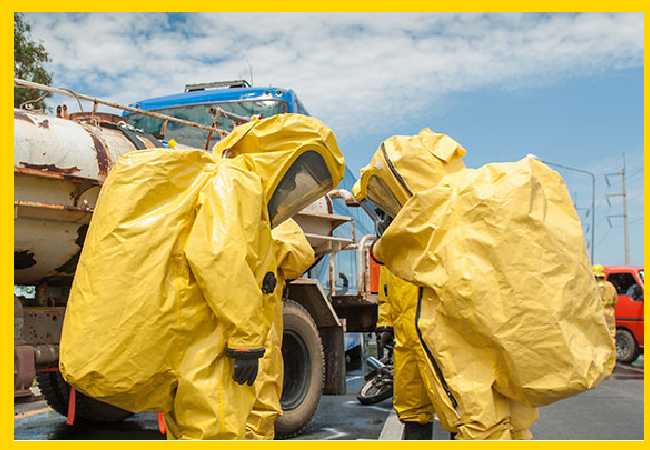Currency
August 26, 2018

To protect personnel and manage compliance with OSHA’s HAZWOPER Standard at “uncontrolled hazardous waste sites” (e.g., Superfund sites), EHS professionals must have a full understanding of the Standard—especially the training requirements. Providing effective, up-to-date HAZWOPER training means knowing which employees are covered by which HAZWOPER requirements, in which situations, and what they must know before performing work that could endanger their health and well-being.
OSHA’s single HAZWOPER Standard at 29 CFR 1910.120 applies to three separate groups of employees, which can cause confusion when seeking out or delivering HAZWOPER training. Each of the three covered groups works toward a different objective, and each has different responsibilities when it comes to HAZarodus Waste OPerations and Emergency Response (HAZWOPER). As such, OSHA also maintains three sets of training requirements within the HAZWOPER rules.
Do you work at a Superfund site or other uncontrolled hazardous waste site? Keep your HAZWOPER cleanup certification up-to-date with Lion’s 8-Hour OSHA HAZWOPER Refresher online course.
To provide the right kind of HAZWOPER training for personnel who perform cleanup work, site safety officers must first know which group his or her employees fall into:
Uncontrolled hazardous waste site cleanup operations personnel
Treatment, storage, and disposal facility (TSDF) employees
Hazardous substance emergency responders
Emergency response, as defined by OSHA, occurs when a hazardous substance is released and “employees from outside the immediate release area” or “other designated responders” respond to an occurrence that results, or is likely to result, in an uncontrolled release of a hazardous substance.

In other words, when an emergency release occurs, specially trained employees must respond to neutralize the immediate threat to personnel, the environment, and the public.
Cleanup at a hazardous waste site, on the other hand, has its own very specific definition under the Standard. Cleanup may be required after an emergency response event—or as part of a separate hazardous waste site cleanup operation.
A site is considered a “hazardous waste site” if it is:
Identified or listed by a government agency as an uncontrolled hazardous waste site.
Listed, or proposed for listing on:
The National Priorities List, or
A State priority list.
Regulated as a corrective action covered by RCRA.
HAZWOPER training is required for all employees working on site that could be exposed to hazardous substances, safety, or health hazards, their supervisors, and management responsible for the site, before they are permitted to engage in or supervise hazardous waste operations. The Site Safety and Health Officer oversees employee training and uses information obtained from job hazard analyses to design a training program that meets specific needs of the employees.
Within the HAZWOPER cleanup training rules, OSHA lists different categories of employees found on a typical hazardous waste cleanup site. Workers are grouped by the type of work they perform and how often they are present on site. For each category, there is a prescribed minimum number of initial OSHA training hours that must be fulfilled.
General Site Workers have a regular presence on the job and perform tasks that may expose them to hazardous substances and health and safety hazards. Hazardous substance removal personnel, equipment operators, laborers, and management all fall under the category of general site workers. General site workers must initially receive a minimum of 40 hours of off-site training plus three days of hands-on experience in the field.
OSHA’s single HAZWOPER Standard at 29 CFR 1910.120 applies to three separate groups of employees, which can cause confusion when seeking out or delivering HAZWOPER training. Each of the three covered groups works toward a different objective, and each has different responsibilities when it comes to HAZarodus Waste OPerations and Emergency Response (HAZWOPER). As such, OSHA also maintains three sets of training requirements within the HAZWOPER rules.
Do you work at a Superfund site or other uncontrolled hazardous waste site? Keep your HAZWOPER cleanup certification up-to-date with Lion’s 8-Hour OSHA HAZWOPER Refresher online course.
To provide the right kind of HAZWOPER training for personnel who perform cleanup work, site safety officers must first know which group his or her employees fall into:
What’s the difference between cleanup and emergency response?
Emergency response, as defined by OSHA, occurs when a hazardous substance is released and “employees from outside the immediate release area” or “other designated responders” respond to an occurrence that results, or is likely to result, in an uncontrolled release of a hazardous substance.

In other words, when an emergency release occurs, specially trained employees must respond to neutralize the immediate threat to personnel, the environment, and the public.
Cleanup at a hazardous waste site, on the other hand, has its own very specific definition under the Standard. Cleanup may be required after an emergency response event—or as part of a separate hazardous waste site cleanup operation.
A site is considered a “hazardous waste site” if it is:
Who needs training to work at a hazardous waste cleanup site?
HAZWOPER training is required for all employees working on site that could be exposed to hazardous substances, safety, or health hazards, their supervisors, and management responsible for the site, before they are permitted to engage in or supervise hazardous waste operations. The Site Safety and Health Officer oversees employee training and uses information obtained from job hazard analyses to design a training program that meets specific needs of the employees.
Within the HAZWOPER cleanup training rules, OSHA lists different categories of employees found on a typical hazardous waste cleanup site. Workers are grouped by the type of work they perform and how often they are present on site. For each category, there is a prescribed minimum number of initial OSHA training hours that must be fulfilled.
General Site Workers have a regular presence on the job and perform tasks that may expose them to hazardous substances and health and safety hazards. Hazardous substance removal personnel, equipment operators, laborers, and management all fall under the category of general site workers. General site workers must initially receive a minimum of 40 hours of off-site training plus three days of hands-on experience in the field.









